Skyline
A skyline is the outline or shape created by a city's overall structure, or by human intervention in a non-urban setting or in nature that is formed where the sky meets buildings or the land. City skylines serve as a pseudo-fingerprint as no two skylines are alike. For this reason, news and sports programs, television shows, and movies often display the skyline of a city to set a location. The term The Sky Line of New York City was first introduced in 1896, when it was the title of a color lithograph by Charles Graham for the color supplement of the New York Journal.[1]
Paul D. Spreiregen, FAIA, has called a skyline "a physical representation [of a city's] facts of life ... a potential work of art ... its collective vista."[2]
History
Early examples
 The Great Wall of China transforming a natural skyline
The Great Wall of China transforming a natural skyline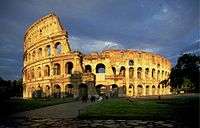
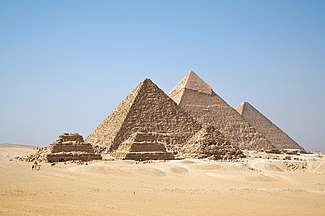 Giza pyramids
Giza pyramids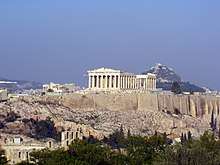
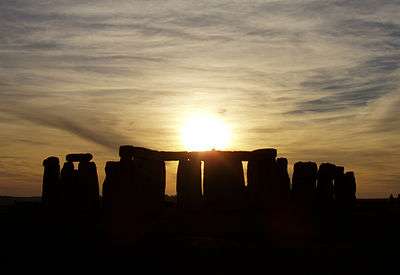 Stonehenge's skyline has been known for millennia
Stonehenge's skyline has been known for millennia
Modern city skylines
Some natural skylines have been unintentionally modified for commercial purposes.
 Skyline of Hong Kong
Skyline of Hong Kong
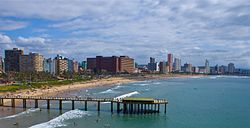 Skyline of Durban
Skyline of Durban.jpg)

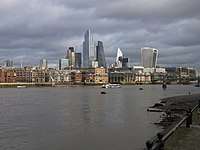 City of London skyline
City of London skyline
- Ski lift pylon in Italy transforming a natural skyline
Features
High-rise buildings
High-rise buildings, including skyscrapers, are the fundamental feature of urban skylines.[3][4]
Towers
Towers from different eras make for contrasting skylines.
San Gimignano, in Tuscany, Italy, has been described as having an "unforgettable skyline" with its competitively built towers.[5]
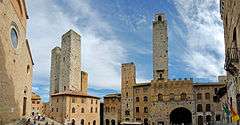 San Gimignano Towers
San Gimignano Towers 9 Water towers in Villejuif (Paris)
9 Water towers in Villejuif (Paris) A cell phone tower making a surreal addition to the skyline
A cell phone tower making a surreal addition to the skyline
Sports stadiums

The Colosseum and 2008 Beijing Olympic Stadium give varied sport stadium skylines.
Remote locations
Some remote locations have striking skylines, created either by nature or by sparse human settlement in an environment not conducive to housing significant populations.

Architectural features
Notable architects influencing skyline
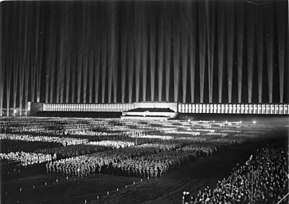
Norman Foster served as architect for the Gherkin in London and the Hearst Tower in Midtown Manhattan, and these buildings have to added to their cities' skylines.
Albert Speer made a notable night time skyline with searchlights at Nuremberg.
Use of skylines in media
Skylines are sometimes used as backgrounds for movies, television shows, news websites, and in other forms of media.
Subjective ranking of skylines
Several services rank skylines based on their own subjective criteria. Emporis is one such service, which uses height and other data to give point values to buildings and add them together for skylines.
References
- "Moving Uptown". New York Public Library. Archived from the original on 2014-12-29.
When Charles Graham's view of New York was published, the new term used in the title, "sky line," caught on immediately.
- Paul D. Spreiregen (1965). Urban Design: The Architecture of Towns and Cities. McGraw-Hill.
- Heath, Tom; Smith, Sandy G.; Lim, Bill (July 2000). "Tall Buildings and the Urban Skyline: The Effect of Visual Complexity on Preferences". Environment and Behavior. 32 (4): 541–556. doi:10.1177/00139160021972658. ISSN 0013-9165.
- McNeill, Donald (February 2005). "Skyscraper geography". Progress in Human Geography. 29 (1): 41–55. doi:10.1191/0309132505ph527oa.
geographers have tended to neglect the substantial impact of skyscrapers on urban life.
- Centre, UNESCO World Heritage. "Historic Centre of San Gimignano". whc.unesco.org. Archived from the original on 2016-08-04.
Further reading
- Emporis ranking of cities by the visual impact of their skylines
- Attoe, Wayne (1981). Skylines: understanding and molding urban silhouettes. Wiley. ISBN 9780471279402.
- Bacon, Edmund (1967). Design of Cities. Thames & Hudson. ISBN 978-0-14-004236-8.
- Lim, Bill; Heath, Tom (1993). Hayman H. (ed.). "What is skyline: a quantitative approach". Architectural Science: Past, Present and Future, Proceedings of the Conference of the Australian and New Zealand Architectural Science Association: 23–32.
- Ford, Larry R. (1976). "The urban skyline as a city classification system". Journal of Geography. 75 (3): 154–164. doi:10.1080/00221347608980594.
External links
| Wikimedia Commons has media related to Skylines. |


